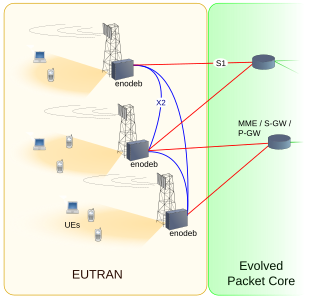
Enhanced Data rates for GSM Evolution (EDGE) is a digital mobile phone technology that allows improved data transmission rates as a backward-compatible extension of GSM. EDGE is considered a pre-3G radio technology and is part of ITU's 3G definition. EDGE was deployed on GSM networks beginning in 2003 – initially by Cingular in the United States.
General Packet Radio Service (GPRS) is a packet oriented mobile data standard on the 2G and 3G cellular communication network's global system for mobile communications (GSM). GPRS was established by European Telecommunications Standards Institute (ETSI) in response to the earlier CDPD and i-mode packet-switched cellular technologies. It is now maintained by the 3rd Generation Partnership Project (3GPP).
The Universal Mobile Telecommunications System (UMTS) is a third generation mobile cellular system for networks based on the GSM standard. Developed and maintained by the 3GPP, UMTS is a component of the International Telecommunications Union IMT-2000 standard set and compares with the CDMA2000 standard set for networks based on the competing cdmaOne technology. UMTS uses wideband code-division multiple access (W-CDMA) radio access technology to offer greater spectral efficiency and bandwidth to mobile network operators.

In IEEE 802 LAN/MAN standards, the medium access control sublayer is the layer that controls the hardware responsible for interaction with the wired, optical or wireless transmission medium. The MAC sublayer and the logical link control (LLC) sublayer together make up the data link layer. Within the data link layer, the LLC provides flow control and multiplexing for the logical link, while the MAC provides flow control and multiplexing for the transmission medium.
Non-access stratum (NAS) is a functional layer in the UMTS and LTE wireless telecom protocol stacks between the core network and user equipment. This layer is used to manage the establishment of communication sessions and for maintaining continuous communications with the user equipment as it moves. The NAS is defined in contrast to the Access Stratum which is responsible for carrying information over the wireless portion of the network. A further description of NAS is that it is a protocol for messages passed between the User Equipment, also known as mobiles, and Core Nodes that is passed transparently through the radio network. Examples of NAS messages include Update or Attach messages, Authentication Messages, Service Requests and so forth. Once the User Equipment (UE) establishes a radio connection, the UE uses the radio connection to communicate with the core nodes to coordinate service. The distinction is that the Access Stratum is for dialogue explicitly between the mobile equipment and the radio network and the NAS is for dialogue between the mobile equipment and core network nodes. For LTE, the Technical Standard for NAS is 3GPP TS 24.301.
+- – - – - -+ +- – - – - – -+ | HTTP | | Application | +- – - – - -+ +- – - – - – -+ | TCP | | Transport | +- – - – - -+ +- – - – - – -+ | IP | | Internet | +- – - – - -+ +- – - – - – -+ | NAS | | Network | +- – - – - -+ +- – - – - – -+ | AS | | Link | +- – - – - -+ +- – - – - – -+ | Channels | | Physical | +- – - – - -+ +- – - – - – -+
The GPRS core network is the central part of the general packet radio service (GPRS) which allows 2G, 3G and WCDMA mobile networks to transmit IP packets to external networks such as the Internet. The GPRS system is an integrated part of the GSM network switching subsystem.
The Radio Network Controller (RNC) is a governing element in the UMTS radio access network (UTRAN) and is responsible for controlling the Node Bs that are connected to it. The RNC carries out radio resource management, some of the mobility management functions and is the point where encryption is done before user data is sent to and from the mobile. The RNC connects to the Circuit Switched Core Network through Media Gateway (MGW) and to the SGSN in the Packet Switched Core Network.

The base station subsystem (BSS) is the section of a traditional cellular telephone network which is responsible for handling traffic and signaling between a mobile phone and the network switching subsystem. The BSS carries out transcoding of speech channels, allocation of radio channels to mobile phones, paging, transmission and reception over the air interface and many other tasks related to the radio network.
The IP Multimedia Subsystem or IP Multimedia Core Network Subsystem (IMS) is an architectural framework for delivering IP multimedia services. Historically, mobile phones have provided voice call services over a circuit-switched-style network, rather than strictly over an IP packet-switched network. Alternative methods of delivering voice (VoIP) or other multimedia services have become available on smartphones, but they have not become standardized across the industry. IMS is an architectural framework to provide such standardization.
GPRS Tunnelling Protocol (GTP) is a group of IP-based communications protocols used to carry general packet radio service (GPRS) within GSM, UMTS and LTE networks. In 3GPP architectures, GTP and Proxy Mobile IPv6 based interfaces are specified on various interface points.
The Mobile Application Part (MAP) is an SS7 protocol that provides an application layer for the various nodes in GSM and UMTS mobile core networks and GPRS core networks to communicate with each other in order to provide services to users. The Mobile Application Part is the application-layer protocol used to access the Home Location Register, Visitor Location Register, Mobile Switching Center, Equipment Identity Register, Authentication Centre, Short message service center and Serving GPRS Support Node (SGSN).

E-UTRA is the air interface of 3rd Generation Partnership Project (3GPP) Long Term Evolution (LTE) upgrade path for mobile networks. It is an acronym for Evolved Universal Mobile Telecommunications System (UMTS) Terrestrial Radio Access, also referred to as the 3GPP work item on the Long Term Evolution (LTE) also known as the Evolved Universal Terrestrial Radio Access (E-UTRA) in early drafts of the 3GPP LTE specification. E-UTRAN is the initialism of Evolved UMTS Terrestrial Radio Access Network and is the combination of E-UTRA, user equipment (UE), and E-UTRAN Node B or Evolved Node B (eNodeB).

High Speed Packet Access (HSPA) is an amalgamation of two mobile protocols, High Speed Downlink Packet Access (HSDPA) and High Speed Uplink Packet Access (HSUPA), that extends and improves the performance of existing 3G mobile telecommunication networks using the WCDMA protocols. A further improved 3GPP standard, Evolved High Speed Packet Access, was released late in 2008 with subsequent worldwide adoption beginning in 2010. The newer standard allows bit-rates to reach as high as 337 Mbit/s in the downlink and 34 Mbit/s in the uplink. However, these speeds are rarely achieved in practice.
The Short Message Service is realised by the use of the Mobile Application Part (MAP) of the SS7 protocol, with Short Message protocol elements being transported across the network as fields within the MAP messages. These MAP messages may be transported using "traditional" TDM based signalling, or over IP using SIGTRAN and an appropriate adaptation layer.
System Architecture Evolution (SAE) is the core network architecture of mobile communications protocol group 3GPP's LTE wireless communication standard.
GTP' is an IP based protocol used within GSM and UMTS networks. It can be used with UDP or TCP. GTP' uses the same message structure as GTP, but it is largely a separate protocol. GTP' uses registered UDP/TCP port 3386.
A Home Node B, or HNB, is the 3GPP's term for a 3G femtocell or Small Cell.
A Home eNodeB, or HeNB, is the 3GPP's term for an LTE femtocell or Small Cell.
Packet Forwarding Control Protocol (PFCP) is a 3GPP protocol used on the Sx/N4 interface between the control plane and the user plane function, specified in TS 29.244. It is one of the main protocols introduced in the 5G Next Generation Mobile Core Network, but also used in the 4G/LTE EPC to implement the Control and User Plane Separation (CUPS). PFCP and the associated interfaces seek to formalize the interactions between different types of functional elements used in the Mobile Core Networks as deployed by most operators providing 4G, as well as 5G, services to mobile subscribers. These 2 types of components are:
- The Control Plane (CP) functional elements, handling mostly signaling procedures
- The User-data Plane (UP) functional elements, handling mostly packet forwarding, based on rules set by the CP elements.
Backhaul Adaptation Protocol (BAP) is a layer 2 Routing protocol used in 5G for Integrated Access and Backhaul (IAB) .





